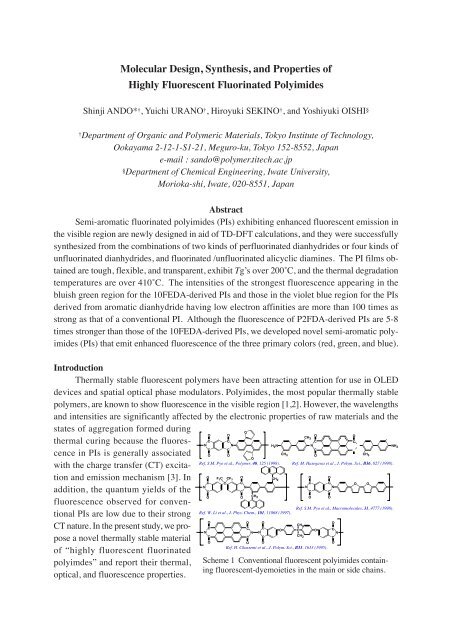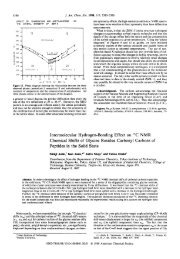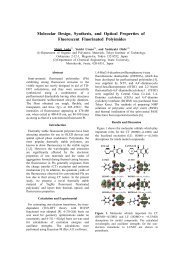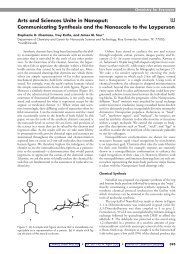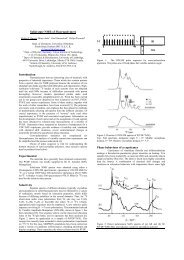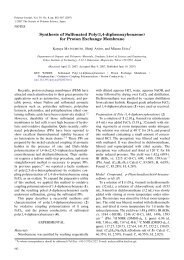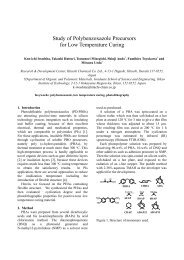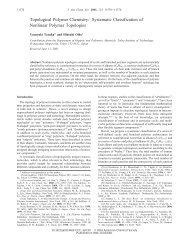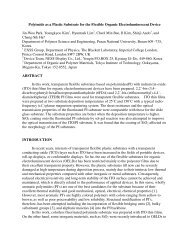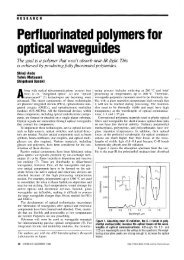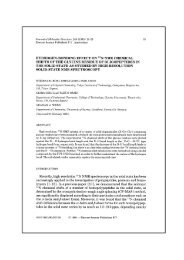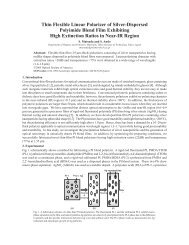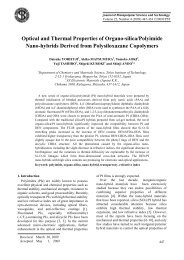Molecular Design, Synthesis, and Properties of Highly Fluorescent ...
Molecular Design, Synthesis, and Properties of Highly Fluorescent ...
Molecular Design, Synthesis, and Properties of Highly Fluorescent ...
You also want an ePaper? Increase the reach of your titles
YUMPU automatically turns print PDFs into web optimized ePapers that Google loves.
<strong>Molecular</strong> <strong>Design</strong>, <strong>Synthesis</strong>, <strong>and</strong> <strong>Properties</strong> <strong>of</strong><br />
<strong>Highly</strong> <strong>Fluorescent</strong> Fluorinated Polyimides<br />
Shinji ANDO* † , Yuichi URANO † , Hiroyuki SEKINO † , <strong>and</strong> Yoshiyuki OISHI §<br />
†Department <strong>of</strong> Organic <strong>and</strong> Polymeric Materials, Tokyo Institute <strong>of</strong> Technology,<br />
Ookayama 2-12-1-S1-21, Meguro-ku, Tokyo 152-8552, Japan<br />
e-mail : s<strong>and</strong>o@polymer.titech.ac.jp<br />
§Department <strong>of</strong> Chemical Engineering, Iwate University,<br />
Morioka-shi, Iwate, 020-8551, Japan<br />
Abstract<br />
Semi-aromatic fluorinated polyimides (PIs) exhibiting enhanced fluorescent emission in<br />
the visible region are newly designed in aid <strong>of</strong> TD-DFT calculations, <strong>and</strong> they were successfully<br />
synthesized from the combinations <strong>of</strong> two kinds <strong>of</strong> perfluorinated dianhydrides or four kinds <strong>of</strong><br />
unfluorinated dianhydrides, <strong>and</strong> fluorinated /unfluorinated alicyclic diamines. The PI films obtained<br />
are tough, flexible, <strong>and</strong> transparent, exhibit Tg’s over 200˚C, <strong>and</strong> the thermal degradation<br />
temperatures are over 410˚C. The intensities <strong>of</strong> the strongest fluorescence appearing in the<br />
bluish green region for the 10FEDA-derived PIs <strong>and</strong> those in the violet blue region for the PIs<br />
derived from aromatic dianhydride having low electron affinities are more than 100 times as<br />
strong as that <strong>of</strong> a conventional PI. Although the fluorescence <strong>of</strong> P2FDA-derived PIs are 5-8<br />
times stronger than those <strong>of</strong> the 10FEDA-derived PIs, we developed novel semi-aromatic polyimides<br />
(PIs) that emit enhanced fluorescence <strong>of</strong> the three primary colors (red, green, <strong>and</strong> blue).<br />
Introduction<br />
Thermally stable fluorescent polymers have been attracting attention for use in OLED<br />
devices <strong>and</strong> spatial optical phase modulators. Polyimides, the most popular thermally stable<br />
polymers, are known to show fluorescence in the visible region [1,2]. However, the wavelengths<br />
<strong>and</strong> intensities are significantly affected by the electronic properties <strong>of</strong> raw materials <strong>and</strong> the<br />
states <strong>of</strong> aggregation formed during<br />
thermal curing because the fluorescence<br />
in PIs is generally associated<br />
with the charge transfer (CT) excitation<br />
<strong>and</strong> emission mechanism [3]. In<br />
addition, the quantum yields <strong>of</strong> the<br />
fluorescence observed for conventional<br />
PIs are low due to their strong<br />
CT nature. In the present study, we propose<br />
a novel thermally stable material<br />
<strong>of</strong> “highly fluorescent fluorinated<br />
polyimdes” <strong>and</strong> report their thermal,<br />
optical, <strong>and</strong> fluorescence properties.<br />
O<br />
O O<br />
CH<br />
O<br />
O<br />
3<br />
C C<br />
C<br />
C<br />
N<br />
N<br />
H 2 N<br />
N<br />
NH 2<br />
C C<br />
C<br />
O O<br />
CH 3 O<br />
CH 3<br />
Ref. S.M. Pyo et al., Polymer, 40, 125 (1998). Ref. M. Hasegawa et al., J. Polym. Sci., B36, 827 (1998).<br />
O<br />
C<br />
N<br />
C<br />
O<br />
O<br />
F 3C CF 3<br />
O<br />
C C<br />
N<br />
C<br />
O<br />
CH 2<br />
CH 2<br />
Ref. W. Li et al., J. Phys. Chem., 101, 11068 (1997).<br />
O<br />
C<br />
N<br />
C<br />
O<br />
O<br />
C<br />
N<br />
C<br />
O<br />
O<br />
C<br />
N<br />
C<br />
O O<br />
O<br />
CH 3<br />
C C<br />
O C O<br />
N N<br />
C C<br />
CH 3<br />
O O<br />
O<br />
Ref. H. Chassemi et al., J. Polym. Sci., B33, 1633 (1995).<br />
O<br />
Ref. S.M. Pyo et al., Macromolecules, 31, 4777 (1998).<br />
Scheme 1 Conventional fluorescent polyimides containing<br />
fluorescent-dyemoieties in the main or side chains.<br />
C<br />
C N<br />
O<br />
O
Calculation <strong>and</strong> Experimental<br />
For evaluating one-electron transitions in PIs,<br />
the time-dependent (TD)-DFT theory with B3LYP<br />
functional was adopted [4], in which 6-311G(d) basis<br />
set was used for geometry optimizations under no constraints,<br />
<strong>and</strong> 6-311++G(d,p) basis set was used for calculations<br />
<strong>of</strong> excitation energies <strong>and</strong> oscillator strengths.<br />
The calculations were performed using Gaussian-98<br />
(Rev.A11) s<strong>of</strong>tware. 1,4-Bis(3,4-dicarboxytrifluoro<br />
phenoxy)tetra fluorobenzene dianhydride (10FEDA)<br />
<strong>and</strong> 1,4-difluoropyromellitic dianhydride, which have<br />
been developed for perfluorinated polyimides [5], were<br />
kindly supplied by NTT Corp, <strong>and</strong> 4,4’-diaminocyclo<br />
hexyl-hexafluoropropane (6FDC) <strong>and</strong> 2,2’-bis(tri<br />
fluoromethyl)-4,4’-diaminobicyclohexyl (TFDC)<br />
were generously supplied by Central Glass Co.Ltd.<br />
4,4’-Diamino cyclohexyl methane (DCHM) was purchased<br />
from Tokyo Kasei. The methods for preparing<br />
NMP solutions <strong>of</strong> poly(amic acid silyl ester) (PASE)<br />
<strong>and</strong> thermal imidization <strong>of</strong> spin-coated PASE films<br />
have been reported elsewhere [6].<br />
Results <strong>and</strong> Discussion<br />
Fig.1 shows the molecular orbitals that play important<br />
roles for the CT (HOMO→LUMO) <strong>and</strong> the<br />
localized excitation (LE: HOMO−n→LUMO) absorptions<br />
for imide model compounds. Comparing<br />
with a st<strong>and</strong>ard model-Ph/An, the combination <strong>of</strong><br />
polyfluorinated anhydride <strong>and</strong> alicyclic amine<br />
(model-4FPh/Ch) exhibits a hypsochromic shift <strong>and</strong><br />
hypochromic effect for the CT absorption but a slight<br />
bathochromic shift <strong>and</strong> a significant hyperchromic<br />
effect for the LE<br />
absorption. It is<br />
well-known that<br />
the intra- <strong>and</strong> intermolecular<br />
CT interactions<br />
<strong>of</strong> PI<br />
chains markedly<br />
reduce their fluorescence<br />
emission.<br />
Hence, the keypoints<br />
to provide<br />
O<br />
C<br />
O<br />
C<br />
O<br />
O<br />
C<br />
O<br />
C<br />
C<br />
O<br />
C<br />
[Ph/An]<br />
LUMO<br />
e −<br />
P6FDA CF 3 O P2FDAO<br />
F O P3FDA O<br />
C<br />
O<br />
C<br />
O<br />
C<br />
N<br />
C<br />
O<br />
HOMO (363 nm, f=0.003)<br />
O CF 3 O<br />
O F O<br />
O O<br />
Ea = 2.57 eV 2.48 eV 2.37 eV<br />
10FEDA F F<br />
O F<br />
C<br />
O<br />
C<br />
O<br />
F<br />
ODPA<br />
39˚ 39˚<br />
O<br />
1.59 eV<br />
O<br />
F F<br />
O<br />
C<br />
O<br />
C<br />
O<br />
O<br />
F<br />
F F<br />
2.04 eV F<br />
O<br />
C<br />
O<br />
C<br />
O<br />
O<br />
C<br />
O<br />
C<br />
O<br />
HQDEA<br />
Calculated Absorbance (arb.unit)<br />
[Ph4F/Ch]<br />
H<br />
LUMO<br />
e −<br />
O<br />
C<br />
N<br />
C<br />
O<br />
F<br />
HOMO (309 nm, f=0.001)<br />
Fig. 1 <strong>Molecular</strong> orbitals essential for the<br />
CT (HOMO→LUMO) <strong>and</strong> LE (HOMOn→LUMO)<br />
absorptions for models. The<br />
calculated wavelengths <strong>and</strong> oscillator<br />
strengths for the one-electron transitions to<br />
LUMO are shown in parenthesis.<br />
C<br />
O<br />
C<br />
O<br />
C<br />
O<br />
C<br />
O<br />
0.3<br />
0.2<br />
0.1<br />
LE transition<br />
C<br />
O<br />
C<br />
sBPDA<br />
39˚<br />
1.78 eV<br />
O<br />
O O C<br />
O<br />
C<br />
1.41 eV O<br />
0<br />
250 300 350 400 450<br />
O<br />
C<br />
O<br />
C<br />
O<br />
a) Ph/An O b) Ph4F/An O<br />
42° C<br />
46° C<br />
N N<br />
C<br />
C<br />
CF 3<br />
O<br />
C<br />
O<br />
C<br />
O<br />
Wavelength (nm)<br />
O<br />
C<br />
O<br />
C<br />
BISPDA<br />
C<br />
O<br />
PMDA<br />
6FDA<br />
O<br />
CF 3<br />
45˚<br />
C C<br />
O<br />
C<br />
O<br />
O<br />
c) Ph/Ch O d) Ph4F/Ch O<br />
C<br />
H 90°<br />
90° C<br />
N<br />
H N<br />
C<br />
C<br />
O<br />
O<br />
CT transition<br />
Fig. 2 Calculated absorption spectra <strong>of</strong> four<br />
models using the TD-DFT theroy.<br />
CH 3<br />
C<br />
Fig. 3 Calculated electron affinities <strong>of</strong> dianhydrides (B3LYP/6-311G(d)).<br />
O<br />
O<br />
O<br />
F<br />
F<br />
F<br />
F<br />
F<br />
F<br />
F<br />
F<br />
O
highly fluorescent PIs are, firstly, the suppression <strong>of</strong><br />
CT interactions, secondly, the promotion <strong>of</strong> LE emission<br />
occurring at the anhydride moiety, <strong>and</strong> thirdly, the<br />
suppression <strong>of</strong> the emission-quenching caused by molecular<br />
aggregation. Consequently, 4FPh/Ch is expected<br />
to be more fluorescent than Ph/An. In addition,<br />
the introduction <strong>of</strong> less polarizable <strong>and</strong> bulky –CF 3<br />
groups should be effective to strengthen the fluorescence.<br />
Hence, we decided to use a perfluorinated dianhydride,<br />
P2FDA, 10FEDA, <strong>and</strong> alicyclic diamines,<br />
some <strong>of</strong> which include –CF 3 .<br />
According to the design concept described above,<br />
the PIs depicted in Scheme 2 were synthesized. In order<br />
to avoid gelation <strong>and</strong> to improve solubility <strong>of</strong> precursors,<br />
the in-situ silylesterification method was<br />
adopted [6]. The PI films obtained by thermal curing<br />
at 300˚C for 1.5h under N 2 (ca.10µm-thick) are transparent,<br />
tough, <strong>and</strong> flexible. The pale yellowish color<br />
<strong>of</strong> 10FEDA-derived PIs <strong>and</strong> the deep red color <strong>of</strong><br />
P2FDA-derived PIs originate from the characteristic<br />
absorption peaks at 400 <strong>and</strong> 500 nm, respectively.<br />
These peaks were assigned to the local excitation at<br />
the dianhydride moieties [7]. The Tg’s were observed<br />
at 205–300˚C, <strong>and</strong> the thermal degradation temperatures<br />
(10%wt-loss) are 410–440˚C. As shown in Fig.<br />
4, the fluorescent emission observed at 470–480 nm<br />
for 10FEDA-derived PI films are >100 times as<br />
strong as that <strong>of</strong> a conventional fluorescent PI<br />
(BPDA/PDA). Note that the peak at 400 nm in the<br />
excitation spectra (not shown) coincides well with<br />
Absorbance<br />
R :<br />
O<br />
C<br />
N<br />
C<br />
O<br />
O<br />
C<br />
N<br />
C<br />
O<br />
O F O<br />
C C<br />
N<br />
N<br />
C C<br />
O<br />
F<br />
O<br />
P2FDA<br />
F<br />
F F<br />
O O<br />
F F F F<br />
F<br />
10FEDA<br />
H<br />
C<br />
H<br />
DCHM<br />
BPDA<br />
Alicyclic<br />
Structure : R<br />
F O<br />
C<br />
Alicyclic<br />
N<br />
Structure : R<br />
C<br />
F<br />
O<br />
CF 3<br />
C<br />
CF 3<br />
6FDC<br />
CHA<br />
CF 3<br />
O<br />
C<br />
N<br />
TFDC R'<br />
C<br />
R': CF 3 (87%), CH 3 (11%)<br />
O PDA<br />
Scheme 2. Newly designed highly fluorescent<br />
PIs that can be synthized from P2FDA,<br />
10FEDA <strong>and</strong> alicyclic diamines, <strong>and</strong> a conventional<br />
aromatic PI (BPDA/PDA). Aromatic<br />
dianhydrides with low Ea can be used.<br />
2<br />
1<br />
0<br />
BPDA/PDA<br />
P2FDA/DCHM<br />
10FEDA/DCHM<br />
HQDEA/DCHM<br />
ODPA/DCHM<br />
300 400 500 600 700 800<br />
Wavelength / nm<br />
Fig. 3 Experimental UV/Vis absorption spectra<br />
<strong>of</strong> the PIs formed on silica. The PIs derived<br />
from P2FDA <strong>and</strong> 10FEDA exhibit characteristic<br />
peaks in at 500 <strong>and</strong> 400nm regardless<br />
<strong>of</strong> the diamine structures.<br />
Fluorescence Intensity / arb.unit<br />
1000<br />
100<br />
10<br />
10FEDA/TFDC<br />
10FEDA/6FDC<br />
sBPDA/PDA<br />
10FEDA/DCHM<br />
1<br />
400 500 600 700<br />
Wavelength / nm<br />
Fig. 4 Experimental emission (fluorescence) spectra<br />
<strong>of</strong> PIs derived from 10FEDA <strong>and</strong> BPDA/PDA.<br />
The excitation peak (not shown) concides with the<br />
characteristic absorption peak in Fig.3.<br />
Fluorescence Intensity / arb.unit<br />
100<br />
10<br />
P2FDA/TFDC<br />
P2FDA/6FDC<br />
P2FDA/DCHM<br />
sBPDA/PDA<br />
1<br />
400 500 600 700 800<br />
Wavelength / nm<br />
Fig. 5 Experimental emission (fluorescence) spectra<br />
<strong>of</strong> PIs derived from P2FDA <strong>and</strong> BPDA/PDA.<br />
The excitation peak (not shown) concides with the<br />
characteristic absorption peak in Fig.3.
the characteristic absorption peak as seen in Fig.<br />
3. In addition, the excitation <strong>and</strong> emission peaks<br />
are located in the same ranges regardless <strong>of</strong> the<br />
diamine strutures. These facts indicates that the<br />
CT interactions are effectively suppressed, <strong>and</strong> the<br />
LE excitation/ emission mechanism is predominant<br />
in these PIs. Situation is similar for the<br />
P2FDA-derived PIs, but the fluorescent emission<br />
at 580 <strong>and</strong> 680–700 nm are much weaker than<br />
those <strong>of</strong> the 10FEDA-derived PIs. This suggests<br />
that the CT emission mechanism still remains due<br />
to the significant intermolecular interactions between<br />
the P2FDA moieties.<br />
Finally, we tried to use non-fluorinated aromatic dianhydrides having low electron affinities,<br />
ODPA, HQDEA, <strong>and</strong> BISPDA (Scheme 1). The lowered elecrton-withdrawing properties<br />
<strong>of</strong> these dianhydrides should reduce the intra- <strong>and</strong> intermolecular CT interactions, which can<br />
enhance the LE excitation <strong>and</strong> emission mechanisms. As shown in Fig.6, the PIs synthesized<br />
from such dianhydrides <strong>and</strong> alicyclic diamines exhibit strong emission at 380-420 nm (violet to<br />
blue). The intensities <strong>of</strong> the fluorescence is as strong as those <strong>of</strong> the 10FEDA-derived PIs.<br />
Conclusion<br />
Novel semi-aromatic polyimides<br />
(PIs) that emit enhanced<br />
fluorescence <strong>of</strong> the three primary<br />
colors (red, green, <strong>and</strong> blue) were<br />
designed in aid <strong>of</strong> TD-DFT calculations<br />
<strong>and</strong> successfully synthesized<br />
using combinations <strong>of</strong><br />
perfluorinated dianhydrides or<br />
1<br />
350 400 450 500 550 600 650 700<br />
Wavelength / nm<br />
non-fluorinated dianhydrides having ether-linkages <strong>and</strong> fluorinated / unfluorinated alicyclic diamines.<br />
The PI films are tough, flexible, <strong>and</strong> have Tg’s over 200˚C. The wavelengths <strong>of</strong> the<br />
fluorescence can be predicted from the electron affinities <strong>of</strong> dianhydries <strong>and</strong> controled by changing<br />
their structures. The maximum fluorescence intensities in the blue <strong>and</strong> bluish green regions are<br />
more than 100 times as strong as that <strong>of</strong> a conventional PI. These PIs are promising as thermally<br />
stable materials for organic light-emitting devices <strong>and</strong> flat panel displays in near future.<br />
Fluorescence Intensity / arb.unit<br />
1000<br />
100<br />
10<br />
BPDA/PDA<br />
ODPA/DCHM<br />
HQDEA/DCHM<br />
BISPDA/DCHM<br />
BPDA/DCHM<br />
Fig. 6 Experimental emission (fluorescence)<br />
spectra <strong>of</strong> PIs derived from non-fluorinated<br />
dianhydrides having low electron affinities.<br />
P2FDA/DCHM 10FEDA/DCHM BPDA/DCHM<br />
Fig. 7 Photos <strong>of</strong> the PIs newly sythesized, <strong>and</strong> thermally imidized<br />
on silica. The films are illuminated by UV light (350 nm).<br />
References<br />
1. E.D. Wachsman, C.W. Frank, Polymer, 29, 1191 (1988).<br />
2. M. Hasegawa et al, Eur. Polym. J., 25, 349 (1989).<br />
3. M. Hasegawa <strong>and</strong> K. Horie, Prog. Polym. Sci., 26, 259 (2001).<br />
4. S. Ando, T. Fujigaya, <strong>and</strong> M. Ueda, Jpn. J. Appl. Phys. 41, L105 (2002).<br />
5. S. Ando, T. Matsuura <strong>and</strong> S. Sasaki, Macromolecules, 25, 5858-60 (1992).<br />
6. Y. Oishi, K. Ogasawara, H. Hirayama, <strong>and</strong> K. Mori, J. Photopolym. Sci. Technol., 14, 37 (2001).<br />
7. Y. Urano, M. Yoshida, Y. Sato, <strong>and</strong> S. Ando, Polym. Prep. Jpn, 51, 843 (2002).


